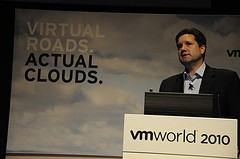 This year’s VM World Europe has come to a close. Not as big as the San Francisco show, but a respectable 7,000 people came to beautiful Copenhagen to hear passionate and geeky techies like myself talk about virtualization.
This year’s VM World Europe has come to a close. Not as big as the San Francisco show, but a respectable 7,000 people came to beautiful Copenhagen to hear passionate and geeky techies like myself talk about virtualization.
My primary reason for straying this far from home was to launch the Dell Management Plug-in for VMware vCenter. This plug-in allows our customers to manage Dell hardware from the vCenter management console with a level of integration not seen in any other plug-in. We’re not the ones saying that, our customers and virtualization industry insiders are. The launch was very successful, with our breakout session so full that they were turning people away at the door.
But, as I talked with customers about how (or even if) virtualization leads them to the cloud, it became obvious to me that the Dell virtualization strategy is different from others in the industry. Here are my top 5 reasons why:
1) We’re open. Our competitors continue to push their closed and proprietary solutions that work great, as long as you purchase everything from them. Our Virtual Integrated System runs great on Dell, but also runs on the competition.
2) We’re capable. For example, the components of VIS can be embedded into our customers’ own systems, allowing them to maintain their existing business processes where they want to, and enhance them where needed.
3) We’re working hard to reduce complexity for customers – our Dell Management Plug-in for VMware vCenter is a great example of this. Simple licensing, simple deployment, and simple configuration. Customers loved the idea of deploying management software as a virtual appliance.
4) We aren’t pushing the standard marketing hype. It’s not just private clouds, or public clouds, or even hybrid clouds. It’s about running business workloads in the right place at the right time, for the right costs. Our VIS Creator supports deployment to multiple hypervisors, multiple vendors’ hardware, and in the future, multiple public clouds.
5) Our strategy is designed around what the customer wants to do, not what we want to let the customer do.
In short, the industry is changing at a tremendous rate and we must be prepared to respond well to the new opportunities and challenges presented to customers in what we are calling the ‘virtual era.’ Troy West summarized this well in his session at VMworld – technology is making the world a smaller and faster place, so how can we help customers adapt? Mine are just a few of the many good reasons to look at Dell and our approach to help customers achieve success.
Also, be sure to check out our Flickr page and YouTube videos (here and here).